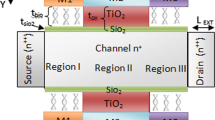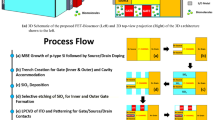Abstract
This work examines a transparent gate recessed channel (TGRC) metal–oxide–semiconductor field-effect transistor (MOSFET) for biosensing, including a nanogap cavity for detection of biomolecules and a transparent gate to enhance the overall current efficiency of the RC-MOSFET. For the detection of neutral biomolecules, electrical characteristics such as ION/IOFF, shift in threshold voltage and change in surface potential have been studied and thereafter, sensitivity of has been evaluated. The biosensor showed enhanced sensitivity for biomolecules with increase in their dielectric value, due to greater on-current owing to the change in capacitances. The capacitances were therefore also evaluated. In addition, immobilization of biomolecules degrades the noise immunity of MOSFET and thereby their overall biosensing performance, while the noise immunity of the TGRC device was very high even in the presence of biomolecules. Furthermore, modulation of the cavity gap length was also investigated, revealing that its increase (from 8 to 20 nm) significantly enhanced the sensitivity of the proposed biosensor. Overall, the results of this analysis reveal that such TGRC-MOSFET biosensors can exhibit high sensitivity (1.45) at very low drain bias (0.2 V), enabling their use for biosensor applications to diagnose various diseases which require lower noise, high speed, low power, and high density.


















Similar content being viewed by others
References
Comini, E., Baratto, C., Concina, I., Faglia, G., Falasconi, M., Ferroni, M., Galstyan, V., Gobbi, E., Ponzoni, A., Vomiero, A., Zappa, D., Sberveglieri, V., Sberveglieri, G.: Metal oxide nanoscience and nanotechnology for chemical sensors. Sens. Actuators B Chem. 179, 3–20 (2013)
Lee, J., Jang, J., Choi, B., Yoon, J., Kim, J.-Y., Choi, Y.-K., Kim, D.M., Kim, D.H., Choi, S.-J.: A highly responsive silicon nanowire/amplifier MOSFET hybrid biosensor. Sci. Rep. 5, 12286 (2015)
Bergveld, P.: The development and application of FET-based biosensors. Biosensors 2(1), 15–33 (1986)
Sang, S., Wang, Y., Feng, Q., Wei, Y., Ji, J., Zhang, W.: Progress of new label-free techniques for biosensors: a review. Crit. Rev. Biotechnol. 36(3), 465–481 (2016)
Im, H., Huang, X.-J., Gu, B., Choi, Y.-K.: A dielectric-modulated field-effect transistor for biosensing. Nat. Nanotechnol. 2(7), 430–434 (2007)
Vu, X.T., Eschermann, J.F., Stockmann, R., GhoshMoulick, R., Offenhäusser, A., Ingebrandt, S.: Top-down processed silicon nanowire transistor arrays for biosensing. Phys. Status Solidi 206(3), 426–434 (2009)
Ahangari, Z.: Performance assessment of dual material gate dielectric modulated nanowire junctionless MOSFET for ultrasensitive detection of biomolecules. RSC Adv. 6(92), 89185–89191 (2016)
Chandan, B.V., Nigam, K., Sharma, D.: Junctionless based dielectric modulated electrically doped tunnel FET based biosensor for label-free detection. Micro Nano Lett. 13(4), 452–456 (2018)
Kanungo, S., Chattopadhyay, S., Gupta, P.S., Sinha, K., Rahaman, H.: Study and analysis of the effects of SiGe source and pocket-doped channel on sensing performance of dielectrically modulated tunnel FET-based biosensors. IEEE Trans. Electron Devices 63(6), 2589–2596 (2016)
Azmi, M.M., Tehrani, Z., Lewis, R., Walker, K.-A., Jones, D., Daniels, D., Doak, S., Guy, O.: Highly sensitive covalently functionalised integrated silicon nanowire biosensor devices for detection of cancer risk biomarker. Biosens. Bioelectron. 52, 216–224 (2014)
Ahn, J.-H., Choi, S.-J., Han, J.-W., Park, T.J., Lee, S.Y., Choi, Y.-K.: Double-gate nanowire field effect transistor for a biosensor. Nano Lett. 10(8), 2934–2938 (2010)
Gao, A., Lu, N., Dai, P., Li, T., Pei, H., Gao, X., Gong, Y., Wang, Y., Fan, C.: Silicon-nanowire-based CMOS-compatible field-effect transistor nanosensors for ultrasensitive electrical detection of nucleic acids. Nano Lett. 11(9), 3974–3978 (2011)
Barsan, R.M.: Analysis and modeling of dual-gate MOSFET’s. IEEE Trans. Electron Devices 28(5), 523–534 (1981)
Gupta, N., Chaujar, R.: Influence of gate metal engineering on small-signal and noise behaviour of silicon nanowire MOSFET for low-noise amplifiers. Appl. Phys. A 122(8), 1–9 (2016)
Gupta, N., Chaujar, R.: Optimization of high-k and gate metal workfunction for improved analog and intermodulation performance of gate stack (GS)-GEWE-SiNW MOSFET. Superlattices Microstruct. 97, 630–641 (2016)
Gupta, N., Chaujar, R.: Investigation of temperature variations on analog/RF and linearity performance of stacked gate GEWE-SiNW MOSFET for improved device reliability. Microelectron. Reliab. 64, 235–241 (2016)
Gupta, N., Kumar, A., Chaujar, R.: Oxide bound impact on hot-carrier degradation for gate electrode workfunction engineered (GEWE) silicon nanowire MOSFET. Microsyst. Technol. 22, 2655–2664 (2015)
Chaujar, R., Kaur, R., Saxena, M., Gupta, M., Gupta, R.: TCAD assessment of gate electrode workfunction engineered recessed channel (GEWE-RC) MOSFET and its multilayered gate architecture—part I: hot-carrier-reliability evaluation. IEEE Trans. Electron Devices 55(10), 2602–2613 (2008)
Chaujar, R., Kaur, R., Saxena, M., Gupta, M., Gupta, R.: Laterally amalgamated DUal material GAte concave (L-DUMGAC) MOSFET for ULSI. Microelectron. Eng. 85(3), 566–576 (2008)
Kumar, A., Gupta, N., Chaujar, R.: Analysis of novel transparent gate recessed channel (TGRC) MOSFET for improved analog behaviour. Microsyst. Technol. 22(11), 2665–2671 (2016)
Kumar, A., Gupta, N., Chaujar, R.: Power gain assessment of ITO based transparent gate recessed channel (TGRC) MOSFET for RF/wireless applications. Superlattices Microstruct. 91, 290–301 (2016)
Kumar, A., Gupta, N., Chaujar, R.: TCAD RF performance investigation of transparent gate recessed channel MOSFET. Microelectron. J. 49, 36–42 (2016)
Kumar, A., Gupta, N., Chaujar, R.: Effect of structured parameters on the hot-carrier immunity of transparent gate recessed channel (TGRC) MOSFET. Microsyst. Technol. 23, 4057–4064 (2017)
Kumar, A., Tripathi, M., Chaujar, R.: Reliability issues of In2O5Sn gate electrode recessed channel MOSFET: impact of interface trap charges and temperature. IEEE Trans. Electron Devices 65, 860–866 (2018)
Kumar, A., Tripathi, M., Chaujar, R.: In2O5 Sn based transparent gate recessed channel MOSFET: RF small-signal model for microwave applications. AEU-Int. J. Electron. Commun. (2018)
Minami, T.: Transparent conducting oxide semiconductors for transparent electrodes. Semicond. Sci. Technol. 20(4), S35 (2005)
Busse, S., Scheumann, V., Menges, B., Mittler, S.: Sensitivity studies for specific binding reactions using the biotin/streptavidin system by evanescent optical methods. Biosens. Bioelectron. 17(8), 704–710 (2002)
Densmore, A., Xu, D.-X., Janz, S., Waldron, P., Mischki, T., Lopinski, G., Delâge, A., Lapointe, J., Cheben, P., Lamontagne, B.: Spiral-path high-sensitivity silicon photonic wire molecular sensor with temperature-independent response. Opt. Lett. 33(6), 596–598 (2008)
Kim, S., Baek, D., Kim, J.-Y., Choi, S.-J., Seol, M.-L., Choi, Y.-K.: A transistor-based biosensor for the extraction of physical properties from biomolecules. Appl. Phys. Lett. 101(7), 073703 (2012)
Davidson, I., Malkinson, M., Strenger, C., Becker, Y.: An improved ELISA method, using a streptavidin-biotin complex, for detecting Marek’s disease virus antigens in feather-tips of infected chickens. J. Virol. Methods 14(3–4), 237–241 (1986)
Zhang, G.-J., Zhang, L., Huang, M.J., Luo, Z.H.H., Tay, G.K.I., Lim, E.-J.A., Kang, T.G., Chen, Y.: Silicon nanowire biosensor for highly sensitive and rapid detection of Dengue virus. Sens. Actuators B Chem. 146(1), 138–144 (2010)
Silvaco, I.: ATLAS User’s Manual, Santa Clara, CA, Ver 5 (2011)
Appenzeller, J., Martel, R., Avouris, P., Knoch, J., Scholvin, J., del Alamo, J.A., Rice, P., Solomon, P.: Sub-40 nm SOI V-groove n-MOSFETs. IEEE Electron Device Lett. 23(2), 100–102 (2002)
Kannan, N., Kumar, M.J.: Dielectric-modulated impact-ionization MOS transistor as a label-free biosensor. IEEE Electron Device Lett. 34(12), 1575–1577 (2013)
Choi, J.-M., Han, J.-W., Choi, S.-J., Choi, Y.-K.: Analytical modeling of a nanogap-embedded FET for application as a biosensor. IEEE Trans. Electron Devices 57(12), 3477–3484 (2010)
Abdi, D.B., Kumar, M.J.: Dielectric modulated overlapping gate-on-drain tunnel-FET as a label-free biosensor. Superlattices Microstruct. 86, 198–202 (2015)
Kranti, A., Armstrong, G.A.: Engineering source/drain extension regions in nanoscale double gate (DG) SOI MOSFETs: analytical model and design considerations. Solid-State Electron. 50(3), 437–447 (2006)
Stern, E., Vacic, A., Reed, M.A.: Semiconducting nanowire field-effect transistor biomolecular sensors. IEEE Trans. Electron Devices 55(11), 3119–3130 (2008)
Kumar, A., Tripathi, M., Chaujar, R.: Investigation of parasitic capacitances of In2O5Sn gate electrode recessed channel MOSFET for ULSI switching applications. Microsyst. Technol. 23, 5867–5874 (2017)
Acknowledgements
The authors are grateful to the University Grants Commission (UGC) for provision of financial assistance to carry out this work.
Author information
Authors and Affiliations
Corresponding author
Rights and permissions
About this article
Cite this article
Kumar, A., Tripathi, M.M. & Chaujar, R. Ultralow-power dielectric-modulated nanogap-embedded sub-20-nm TGRC-MOSFET for biosensing applications. J Comput Electron 17, 1807–1815 (2018). https://doi.org/10.1007/s10825-018-1237-2
Published:
Issue Date:
DOI: https://doi.org/10.1007/s10825-018-1237-2




